September 2012
A Tale of Three Cities
The Baltic States: Estonia, Latvia, Lithuania
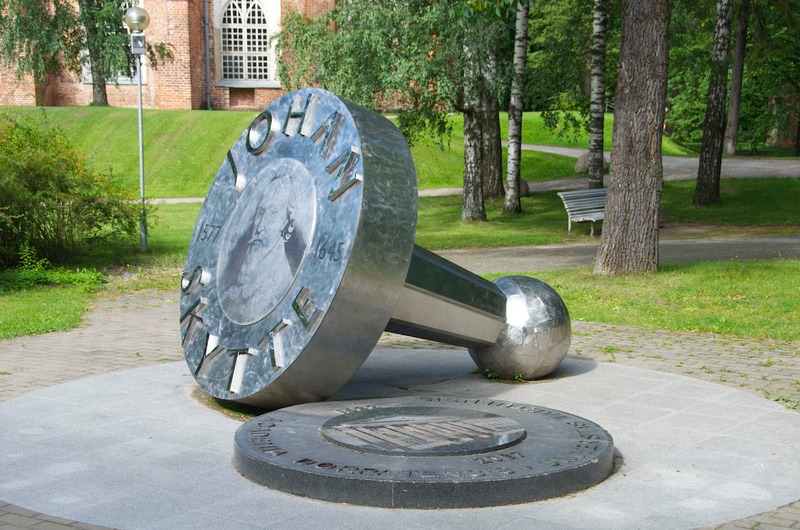
Or… Pawns on the European Chessboard
Estonia, Latvia, and Lithuania: three small countries squashed between Russia and all those bigger guys to the West. The secret Molotov-Ribbentrop Pact of 1939 divided the Baltic States and Poland up between the Germans and Russians. Then after 1944/45, the Soviets simply never left. But these are simply the most recent events. History has not been kind to these people, not for hundreds of years.
Between the wars, from 1918 to 1939 and then again since 1991, when the USSR finally fell apart, each has been an independent country looking for a new reality. It hasn’t been simple, and they’re not done yet, but progress is evident and all three are worthy countries to visit. We enjoyed them.
We spent something over three weeks in the Baltic States, wandering in the countryside and visiting each of the capitals. The countries have lots of similarities, but just as many differences, and each has its own tales to tell. Ultimately, we found that the capital cities – Tallinn, Riga, and Vilnius – were the most interesting part of each country, with the countryside pleasant but never close to knocking your socks off. This is a major departure for us.
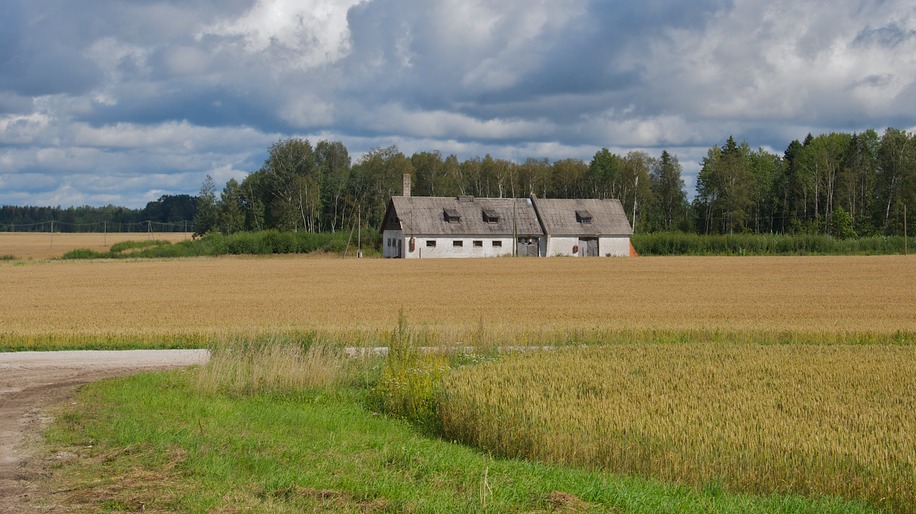
We began in Estonia, crossing the Baltic Sea from Helsinki, Finland and arriving at the port of Tallinn, the capital. As usual, we weren’t ready to enter a new country, and were exhausted from touring the previous one. So we immediately headed for the boonies, looking for someplace to hole up for a couple of days. It proved harder than we had expected. We had become used to “the way it is” in Scandinavia, where we didn’t sweat finding a spot for ourselves. Estonia was different; there weren’t places in the countryside where you could tuck yourself behind a grove of trees, or in a church parking lot, etc. They were there; we just didn’t have the knack of finding them yet.
But we spotted a nice parking lot along a bluff overlooking the ocean, and settled ourselves. It was Saturday, and much too busy with folks stopping to look at the view as they traveled toward the famous resort areas a bit further west, and at one point we were visited by bride, groom, and bridal party as they stopped to pose for those all-important pictures. But it was lots of fun, and we all waved happily at each other.
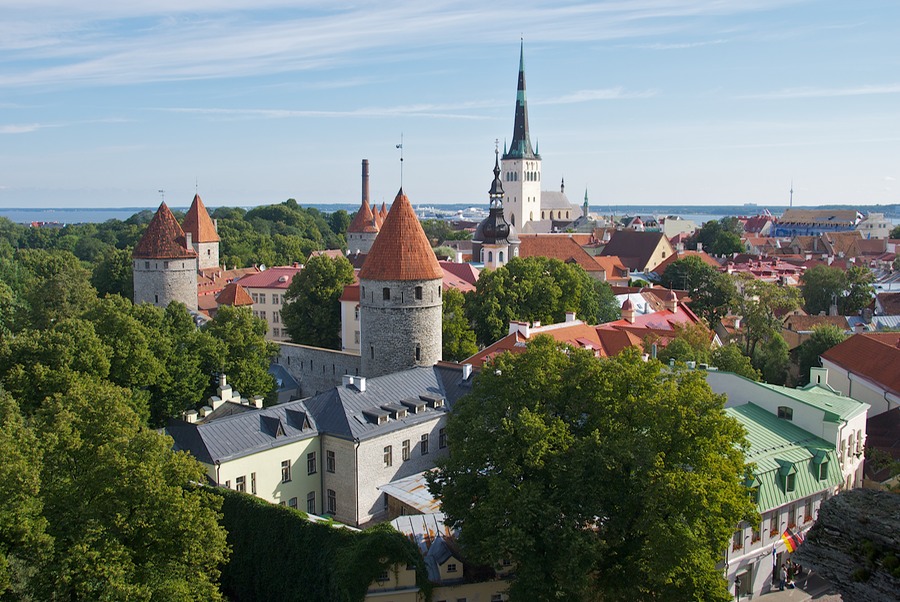
We moved on from there to a piece of open ground near a ruined churchyard and manor house. We were fine – until the owner showed up the next afternoon and wondered who we were. We made his acquaintance, and he said we could stay. Later on he came over to show us some pictures of the old manor house in a book about such places. It seems it once was quite grand. He gave us the website for the activities being held there, www.ohtu.ee, and said they perform plays and give dinners. We later found out this is quite common in Estonia: a quiet way of making some money and helping to get funding for fixing up the old house.
After our rest, we tackled Tallinn, which has a reputation for being a very nice place to visit – we concur. A fortified medieval city of great import, with its ancient center amazingly intact, it was a great introduction to feudal life in Eastern Europe. We had a great parking location right downtown courtesy of some other travelers, and this allowed us the luxury of seeing the town late in the afternoon and then again the following morning; we thus missed most of the day trip groups coming in from the cruise ships in the harbor. It was great! We walked the fortress walls, wandered the maze of streets, poked around old buildings and churches, and bought some lovely chocolate.
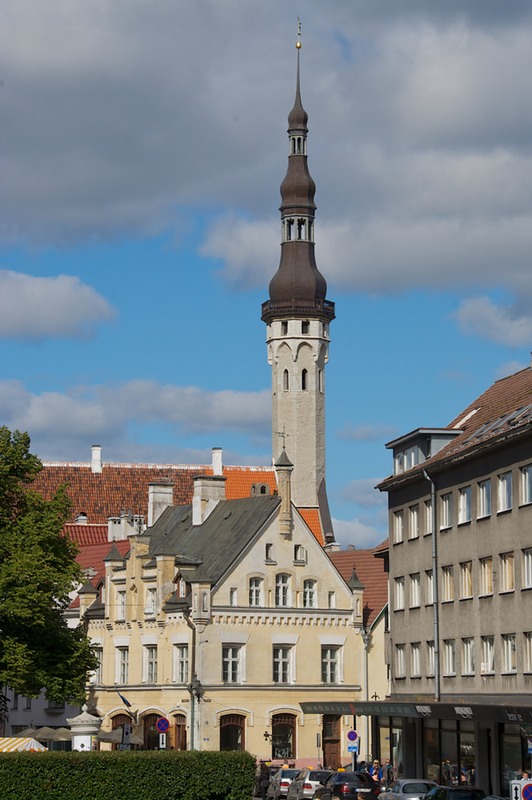
We found a guy selling nifty stickers – not only did he have a nice one for Tallinn for us, but he had about a zillion stickers of flags from all over the world; they covered an entire wall in his little cubbyhole. We went hog wild, buying them for Tanzania, South Africa, Zambia, all kinds of countries we’d love to visit. Only some were labeled, but he had someone dig out a big chart that identified all the flags of the world. We pored over it, puzzling out the answers, and proudly ended up with a trove of goodies. We all had fun, and in the end he let us choose a couple of freebies to add to the dozen or so we were buying; he even let Rick take his picture, muttering “Crazy Americans” we were quite positive. What a hoot!
After two days of wandering, we finally left Tallinn; it had been much fun. Estonia has a proud cultural history, and we really saw that here. We ducked back into town one last time a few days later. We wanted to visit the Museum of Occupations, and it hadn’t been open earlier in the week. Each of the Baltic countries has a museum that addresses what happened to them. The story told here in Tallinn was typically grim – film footage of the Soviet years that preceded and followed those of the Germans. I was able to stand in a horrid “isolation locker” – a tiny space in which I could neither turn around nor sit down. August 20, the day we arrived in the city, is a national holiday – the Day of Restoration of Independence. It had been quiet in Tallinn, but friends who were in Tartu (a university town) that day said there was quite a to-do.
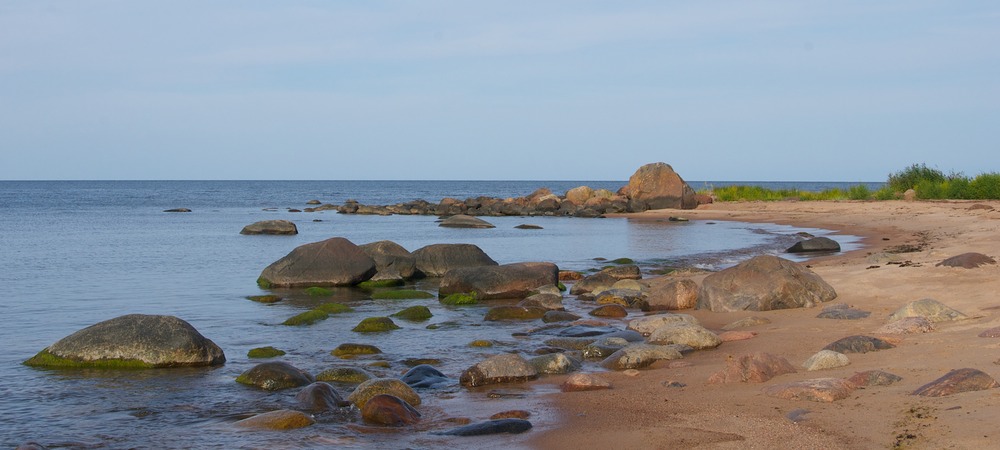
We wandered further east along the coast, ending up at Lahemaa National Park, where we spent a night near the water. Lahemaa is famous for its “erratic stones.” They litter the coastline, having been dropped off by a retreating Icelandic glacier some few years back. They are photogenic and fun, almost as much fun as the raspberries I picked that were growing near our parking spot on the shore. Yummy.
This park is a haven for naturalists and birders, and a great place for cycling (as is the entire Baltic area – there really aren’t any hills, honest). The roads wandered through old forest and past bogs – a delightful, peaceful park. There was plenty of fireweed, now quite mature and in decline this late in August.
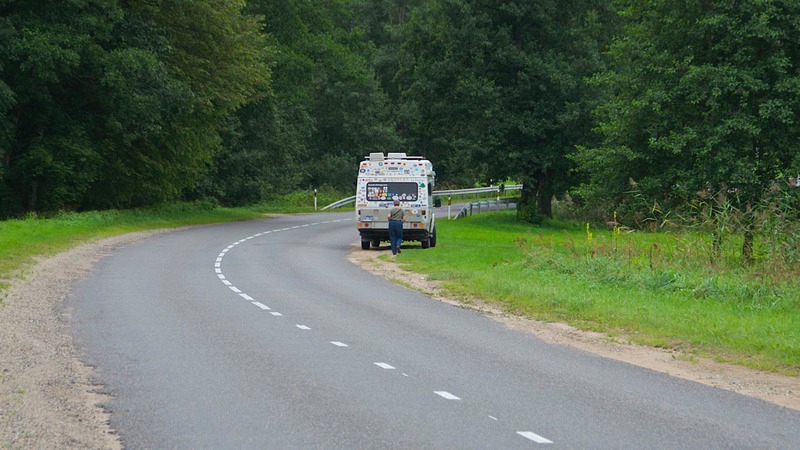
We took a winding route through the countryside, working our way east toward huge Lake Peipsi, fourth largest in Europe and interesting to us in part because of the groups of Old Believers who live there. This area is on the eastern edge of the country; the border with Russia runs right through the lake. Many people left Russia during the bad years to avoid persecution, including this group of individuals with a different belief system. They settled along the banks of the lake, mostly growing onions and other produce for their livelihood. A sad aspect of all this is that the border has been redrawn over the years, dividing the community so that many family members and many of their former community churches are now in Russia. But they are here, managing. We gently wandered through the area, but quickly realized we were uncomfortable – these elderly people weren’t on display, and we hadn’t come to gawk. So on we went. At one point we were stopped by the police, who were doing sobriety checks at ten am. Startling, but harmless; he had to show Rick what to do. Poor lad’s never experienced a breathalyzer before.
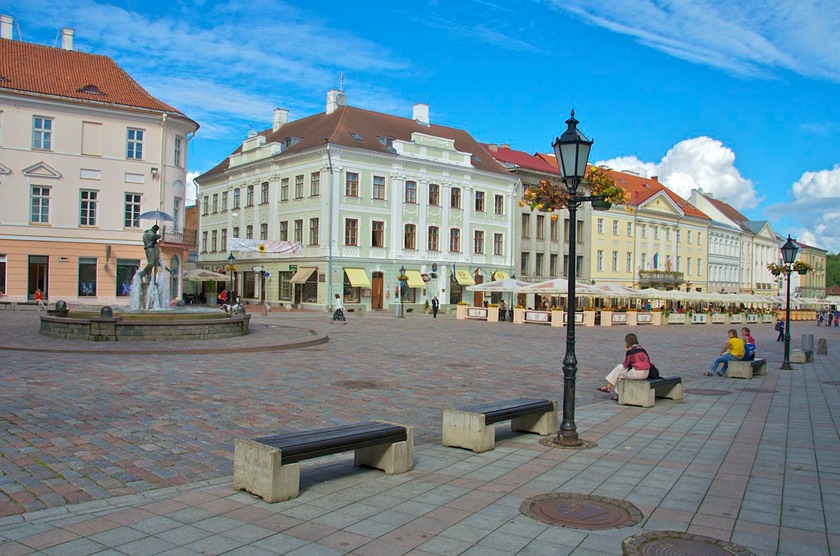
Our last big stop in Estonia was in Tartu, the famous old university town. Ancient, with an interesting history, this was where the 1989 demonstrations and unrest started in Estonia, a part of the widespread commotion that finally ended in the collapse of the USSR in 1991. Aren’t students terrific!! We spent a happy four hours puttering around this old city with its fascinating history. It was a lovely afternoon. We enjoyed the campus area, with its famous observatory (Struve of geodetic arc fame did a lot of his research and study here, and there’s a monument in his honor in front of the funky old building). Another neat monument was the fallen pawn honoring a 16th century scholar that we’ve put at the head of this article. We also saw some building ruins that made us think we were back in Coventry, England; visited a terrific covered market that has been around since day one and which has an enormous bronze statue of a pig in front; and then found a great spot for the night a bit down the road at a small camping area beside a pretty lake. Not too shabby.
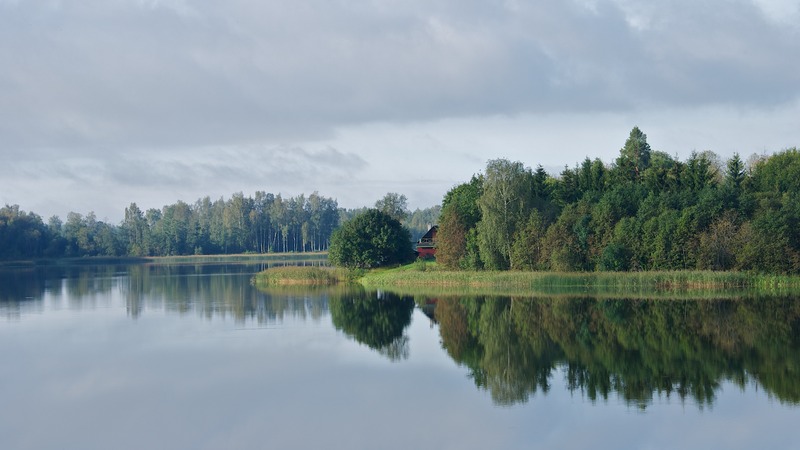
The next day we dropped further south through green, rolling hills (complete with ski jumps, would you believe!) to Otepää, Võru and then Rõuge, all in some of the prettiest countryside we’d seen yet. We drove through Karula National Park, a forest with a floor of ferns alongside hay bundles in the fields. Just before the Latvian border we stopped in Valga, spending the night in a lot by the downtown lake. There were walking paths and play areas getting lots of use by the locals. Not your typical border town, this was a very nice place to spend some time.
We had a quiet night. The next morning we found the post office to get a letter mailed, then turned the corner and were in Latvia. As it turned out, we’d parked for the night within sight of the “border” – which was a sign saying Latvia on one side and Estonia on the other. We left the town of Valga, and entered – Valka. We figure that the border had artificially separated one town into two parts.
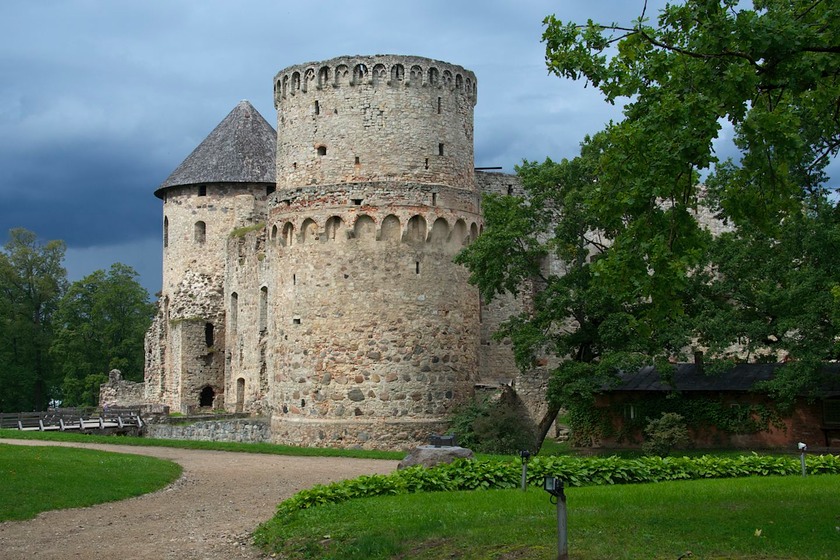
Traveling through the same pine and birch forests we’d been seeing for weeks (pine and birch go quite well together, we’ve decided), we added heather and lichen to the ferns covering the forest floor. We were headed toward Cēsis, a small town with a cool castle, an intriguing medieval church, and interesting pre-war wooden houses. We spent a couple of delightful hours walking around this old town, enjoying the quiet ambiance, and answering questions posed by a couple of young ladies from the university in Riga conducting tourist surveys. This happens to us every once in awhile and is always fun. All the while, enormous thunderheads were building up; we made it back to the coach just as the storm started in. It was a huge storm, with cell after cell passing overhead. We stayed the night, pleased not to have to move on in the bad weather.
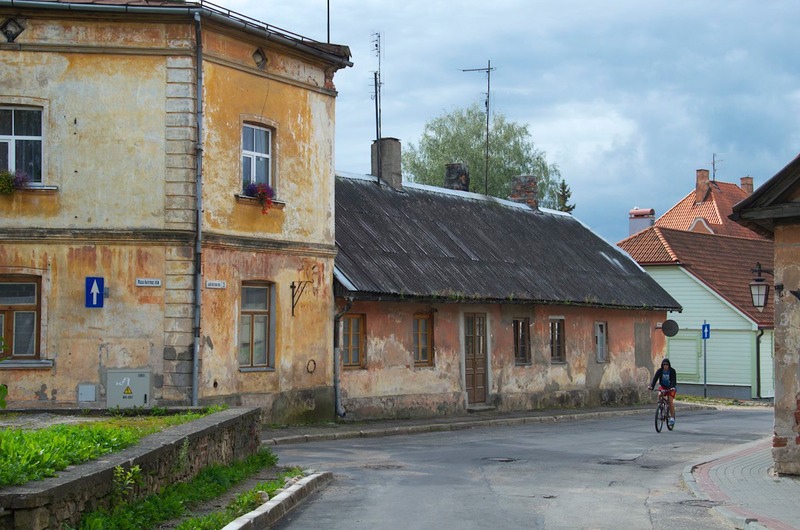
Cēsis was a very nice experience (rain aside); the town is small but has a good sense of itself, with sidewalk cafes, quiet streets, and a lovely park that is the grounds for the castle. We didn’t go into the castle, but expect it also would have been a nice adventure. A couple of weeks later we received a very nice email from a resident who had noticed our truck and noted our website information.
The next morning the sun was shining, and we moved on. We were heading for Riga, another coastal port city. Along the way we stopped to wander through Gauja National Park, enjoying the huge trees and meadows; we saw a red deer crossing the road in front of us, the only wild animal of any size we’ve seen since we left reindeer country! This is a very large park, with castles and monuments and adventure trails, etc. We poked around as we wandered.
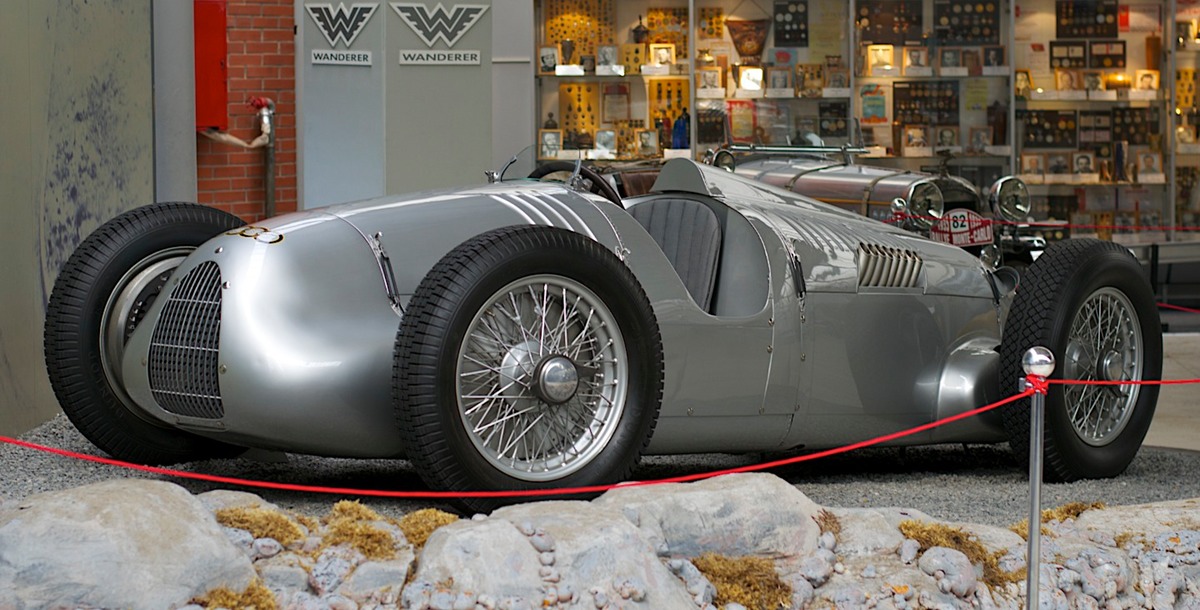
Our Riga adventures were many; it was another success story for us. We started by visiting the Motor Museum, on the outskirts of town. Rick spent hours there and will tell you all about it: Well, this is one cool place. One area of focus is on cars of the soviet era; more Moskvitches, Ladas and Zils than you can shake a stick at. There are also a number of European and American cars of various periods, but nothing particularly special. Until you get to the pièce de résistance, an Auto-Union racing car from the late 30’s. At that point, for someone like me, time stands still. I know I must lose a lot of you when I wax poetic about old cars, but this car and the story behind it are truly special. It is literally the reason that this excellent museum exists. It is truly unique and one of a kind, claimed to be the only surviving original Auto-Union racing car of the period. Some of you may recall that I carried on some about Auto-Unions I saw at the Donnington Park Grand Prix museum in England. Well, beautiful and authentic as they are, those cars are all re-constructions, not original. That’s what makes this car so special. If you are interested in learning more, go to our Motor-Museums.com website and then to the European Museums page to access the complete history of this car and this museum as well as a number of photos. Absolutely spectacular; both the history and the car itself.
They were lovely people in the museum, and said of course we could stay in their parking lot for a couple of nights, and leave the coach during the day to take the bus into the city. They found a nice secluded, quiet spot for us, and viewed us with interest while we were there.
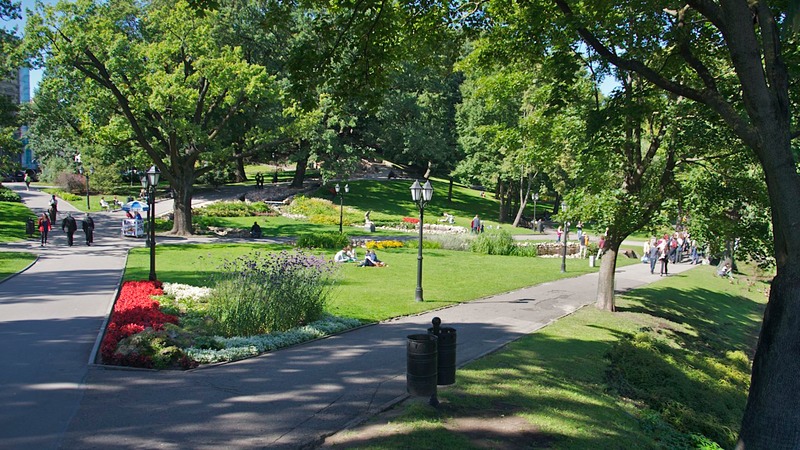
Our day in Riga was just great. Another fine old medieval city, with a cathedral and churches and great museums. The bus dropped us off near the huge central market, with just about everything in the world for sale, including some of the finest strawberries we’ve seen yet (and the last, as it turned out; the season is over now).
As you can imagine, we wandered and thoroughly enjoyed. We visited the War Museum, housed in a tower that was part of the old city fortifications. The building itself was as interesting as the displays. As we visit each new country, we learn about its involvement in all the wars – both ancient and modern – with which we are already familiar; we get a whole new perspective every time.Latvia was invaded by the Soviets in 1940, then “rescued” by Germany in 1941.
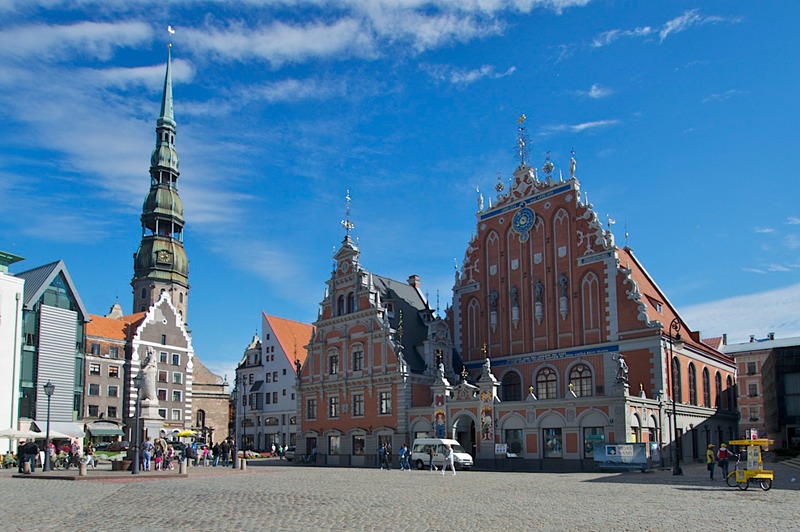
As in neighboring countries, the Latvians were happy to be “rescued” and thought they were in good hands, but soon learned differently. In 1944/45 the Soviets returned, and didn’t leave until 1991. Over the past few months we’ve learned a lot about this period, but have also learned in each country about earlier battles for independence from a variety of invading armies. Each of the Baltic countries has enjoyed short periods of independence at various times in their history, including between the world wars, only to have it taken away again. It’s tough being a small country.
We had lunch out (yes, we had a successful foray into the world of local cuisine) and then spent some time at the Museum of the Occupation. Less reliant on high tech video displays and more creatively done than the museum in Tallinn, it had many very informative displays and lots of text to read, plenty of it in English. The story was horrible, but very well told.
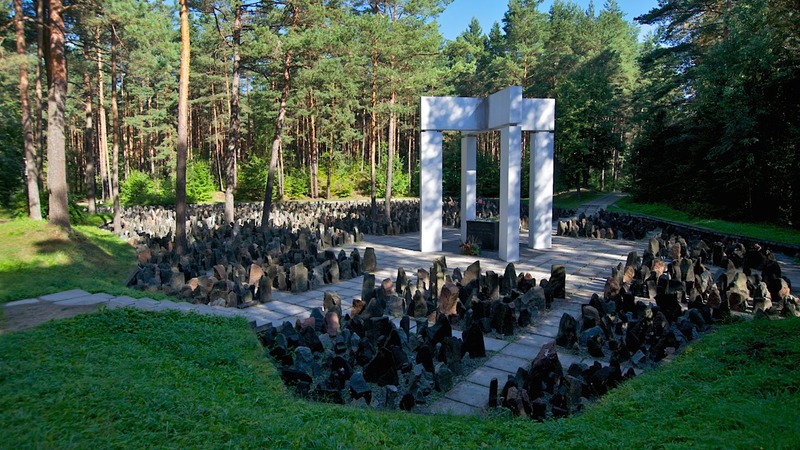
During wartime, the forests in these countries were prime countryside for the shooting and burial of “undesirables.” Rumbula is a site near Riga that was notorious. We had hoped to locate it, but were unable to find the directional sign (others had said the same thing), so I was quite glad that there was very good information at the museum to explain what happened and to offer testimonials from survivors.
Leaving Riga we were able to find the Holocaust memorial south of town. It was quite moving, and we spent a lot of time there – a location deep in the woods but in a clearing that was filled with sunlight.
We also stopped briefly at the memorial to the Salispils concentration camp just a bit further out of town. We couldn’t figure out why the memorial seemed so cold and uninteresting until we realized that it had been constructed by the Soviets (in the 1950’s I believe). It was very impersonal, and contained a grassy area filled with the usual odd Soviet statuary we don’t like. It was quite a contrast to our experience at the simple but effective Holocaust memorial.
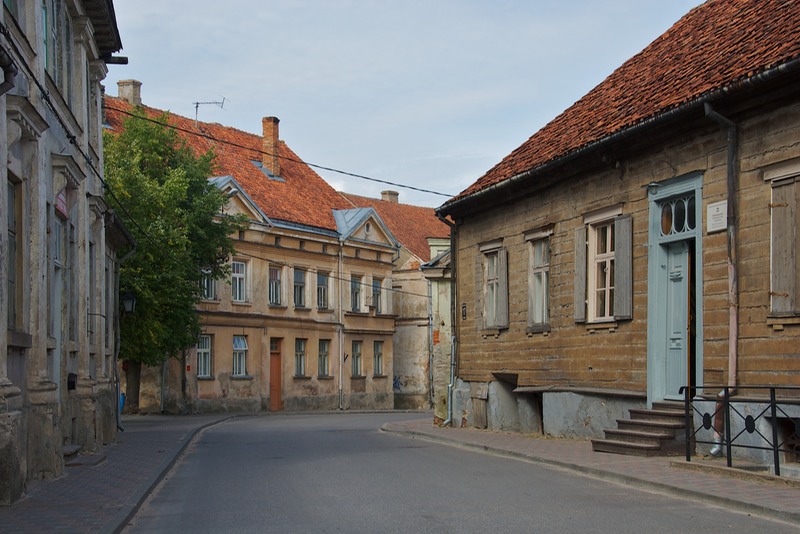
We paused for the night in the old spa town of Kemeri, west of Riga; it used to be quite popular with the Soviets, but now is mostly deserted. Not decrepit, but uncared for. But we had a quiet night parked next to a grassy field, and were joined during the evening by some locals enjoying a game of volleyball.
Moving further out into the countryside, we entered the Abava Valley, formed by glaciers awhile back and filled with apple trees heavy with fruit. Quite nice. We were beginning to see cabbages in the fields, and, increasingly, corn. We poked around Kandava with its castle ruins and Sabile with its vineyards, and spent time in Kuldīga, a nice provincial town that makes the most of an interesting bridge and some nice rapids (“waterfall” to the locals).
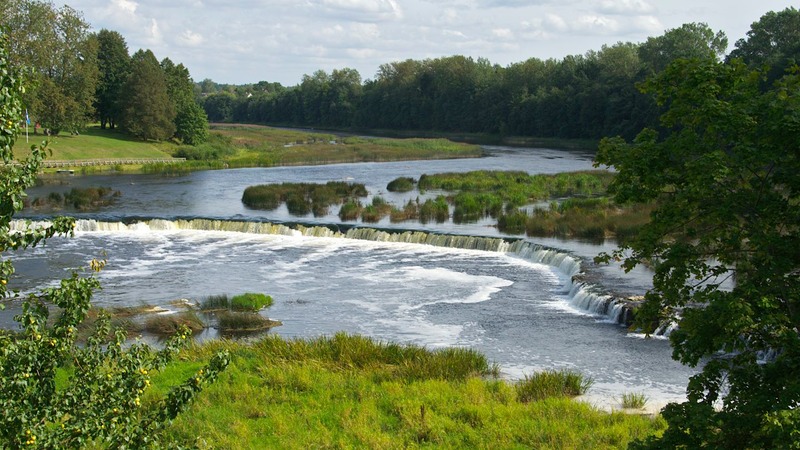
We had thought to stay in Kuldīga, but nothing appealed to us and we went a bit further, locating a very pretty and quiet cemetery area a few miles away. It was tucked back into the trees on a quiet country road. As we look back over our notations of where we’ve stayed the night, we see that increasingly we are locating good spots at cemeteries. Hence, The Cemetery Tour. Typically they are quiet and relatively isolated, have a spot to park, are well cared for and interesting. Works for us! (And, in the end, Latvia gets our vote for best cemeteries in the Baltics.)
After a pleasant night, we moved further south through the gentle hills toward Lithuania. We drove through forests and croplands, seeing more and more corn. Many of the fields were already through for the year. We saw lots of simple stone war monuments. We crossed the border into Lithuania, aka Lietuvos Respublica.
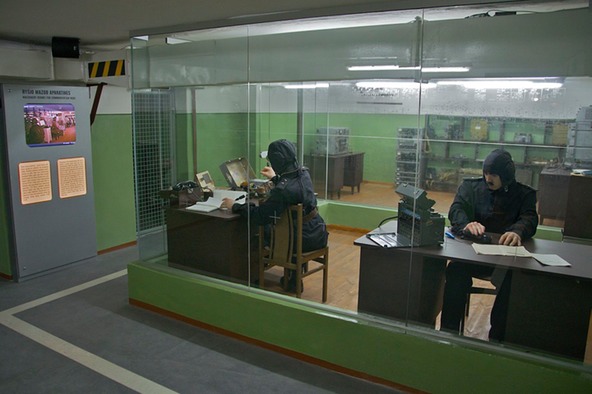
Shortly, we arrived at our first destination, Žemaitija National Park. You need to be aware that national parks in these countries are a bit different than those we are used to in the United States; they are less developed, always include several towns or villages and the normal activities associated therewith, and may have castles or fortresses to be seen… among other things.
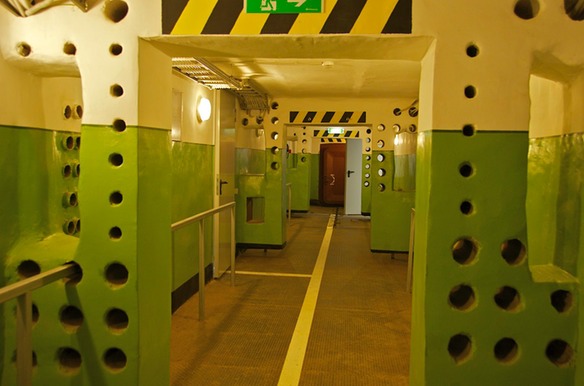
This one had a Cold War Museum, although we didn’t actually know that ahead of time. What we did know was that it contained the disused Soviet-era Plokštinė rocket base and that according to our guidebook this was being developed into a museum. We figured it was worth checking out either way, and on arriving, after considerable difficulty and a distinct lack of signage, sure enough we found that we had arrived at a legitimate Cold War Museum. Cool! It appeared to be brand new. We took the plunge and joined the next tour. Not surprisingly given in Lithuanian, it still was pretty intriguing. We were taken down into the underground command center, peered down into one of the silos and were able to see a number of interesting displays, all with English translations. It was quite moving and well done, which means of course that it was also rather scary.
All in all, it was quite an experience. Up until now, we’d stayed clear of Soviet-era “adventures.” In the Baltics, you can go into former KGB interrogation spots, visit dismantled power plants and mines of various sorts, drive to formerly “hidden” sites where nasty things happened, etc. We’d avoided these places. But this had been worthwhile, and it was a unique opportunity.
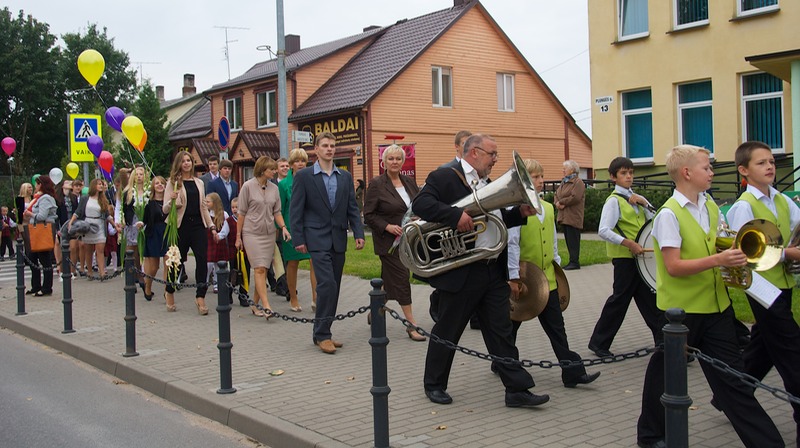
The next morning, we happened to drive through the small town of Rietevas, stopping for a parade. There were parents carrying flowers and dressed for work, children in their school uniforms, balloons, a band and banners. It turned out this was Monday, September 3, the first day of school. In Lithuania, it is National Children’s Day and, while not a holiday, a very special day for all the kids. We couldn’t think of a better way to welcome in the start of a new school year. We happened to have lunch at a McDonalds that day, and the kids were everywhere, all dressed up and so excited and celebratory. Very cool.
We stopped in Kaunas later that day, a good example of medieval Lithuania, with castle and old churches and charming square. It was definitely autumn, with more leaves turning and a real sense of time ticking away. Our guide to the Baltics had said the summer season was “to August 15” and we understood why.
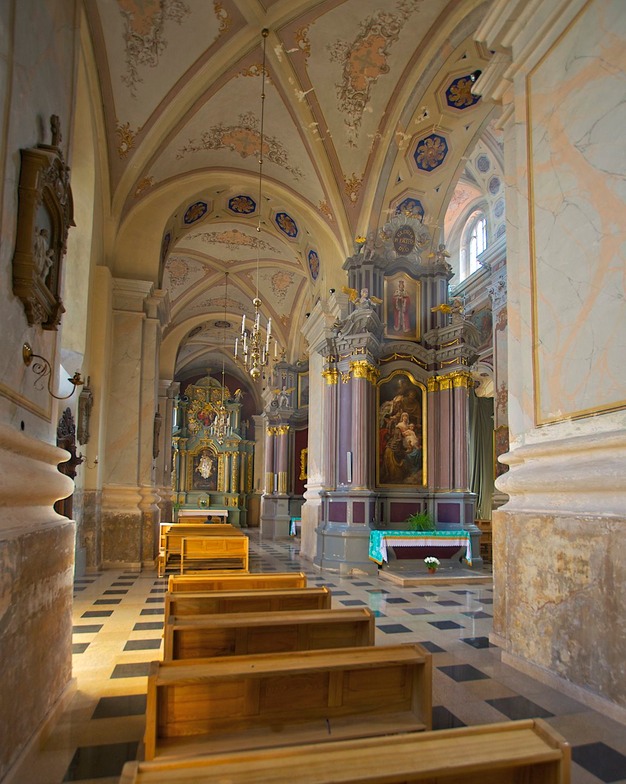
We drifted further south, with the eventual goal of Vilnius, the capital of Lithuania. The countryside was getting nicer, with more obviously “rolling” hills to enjoy. We paused at little towns along the way, enjoying old churches and train stations and horses in the fields. This is very nice country. We knew Vilnius would seem modern, but right now, out in the country, we felt we had stepped back a hundred years or more. It was quite nice.
A short stop in Moletai brought us to the tourist office, looking for internet. It seemed the local source was not available, so he sat us down at a table and let us use their “supply.” He was wonderfully helpful with maps and info on the nearby national park, Aukštaitija, towards which we were headed. He was a terrific example of how friendly and helpful people have continually been in all three of these countries. Even when English language skills are spotty, the welcoming attitude is definitely not.
Our visit to this national park was delightful. By now it was raining, but we drove over and into the woods. We immediately lost about 200 years in time. The forest was dark and the villages were old and it all seemed primeval. We stopped at the Ancient Beekeeping Museum. Pretty funky, but we bought some honey from the lady… and from an old man who was carefully parked in the lot waiting for passersby.He only spoke German, but he had both honey and some wooden toys available. We’ve since been eating his honey, and it’s lovely.
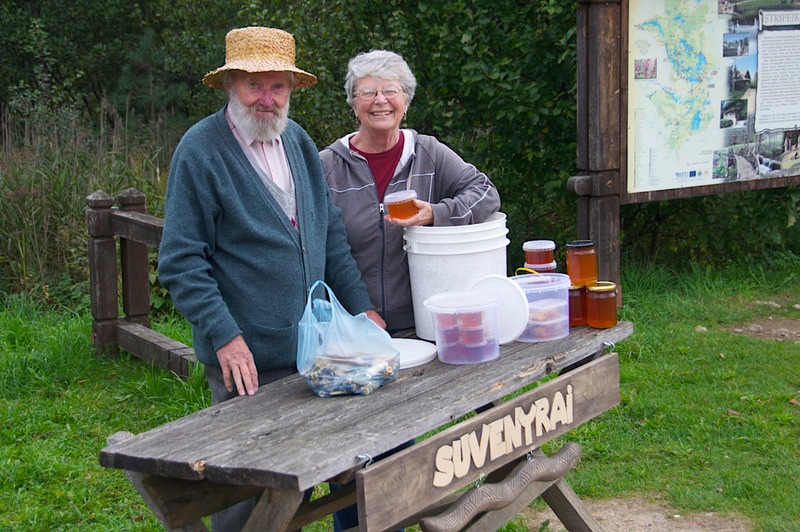
Moving on, we drifted past the Museum of the Horse; only active in the summer when they have horses in the fields, and a museum to learn about them. We’ve gotten out of season. Time to head to Vilnius. But two other stops first.
Being the sort we are, we couldn’t miss out on the Europos Geographicus Centras, 27 Kms north of the capital. Kinda silly, but we stopped and recorded the event anyway. Claiming to be the official center of Europe at GPS: N54 54.478 E25 19.217. We bypassed a second claimant to this title we saw later in Poland. Guess it all depends on what the definition of “Europe” is.
And Kathy desperately needed to visit the WHS Hill Fortress at Kernavė. It was quite cool; there were four mounds that had held fortresses up until the fourteenth century; this spot had been the center of the pre-Christian Lithuanian world.(It was only in the 14th century that Lithuania finally officially accepted Christianity.) I climbed to the tops of the mounds, admiring the view of the Neris River below and the distant vistas. It was a neat experience for me, connecting once again with the pagan world.
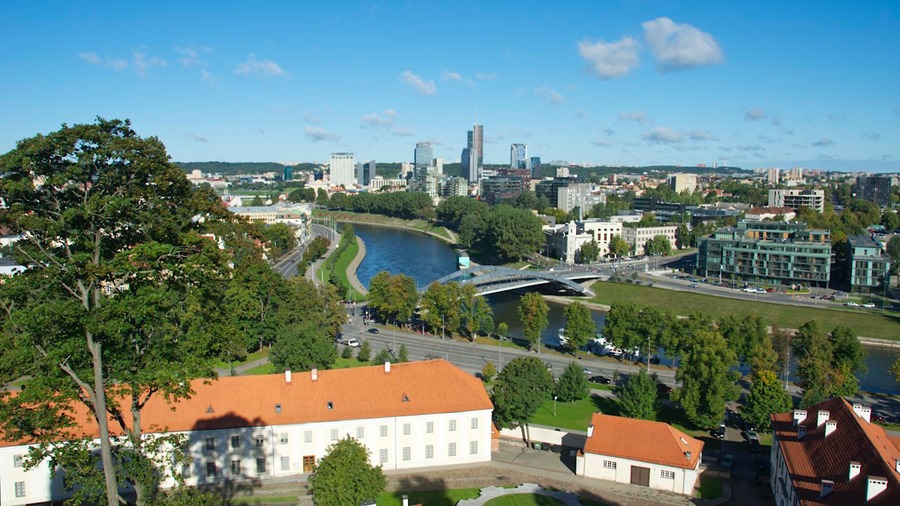
As we approached the capital, houses got fancier, and the cars did too. It quickly became apparent that here was where the Lithuanian money lived. We also saw and heard more Russian than ever before, but didn’t know whether to connect that fact to the increasing signs of prosperity we were seeing around us.
On our way into the city, we ducked over to Trakai, a city with a castle that is supposed to be pretty swift. Didn’t make it with us; all we really noticed was the tremendously touristy area, people wanting money to let you park for a minute and take a picture, and a pretty boring castle to boot. We quickly moved on. Others have loved it.
But then we came to Vilnius. And Vilnius charmed us. It’s a city filled with lovely churches (we quickly picked out 2-3 we wanted to see and bypassed the rest). We had been given a good location for staying overnight, right in the middle of the old city, and it really helped. We arrived late in the afternoon, but did an hour’s walk around to acquaint ourselves with what was where. Being a Saturday, we saw three bridal parties arriving/leaving churches and jamming up the streets. Great fun.
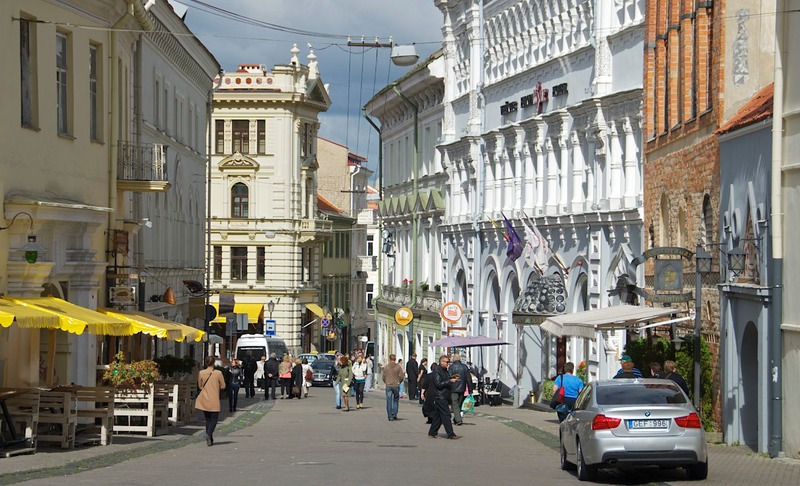
And then, the next morning we awoke to soldiers barricading off our little parking area as part of a complete blocking off of the entire main street through medieval Vilnius. We asked what the deal was, and were told that today was the Vilnius Marathon. When would we be able to leave?About 1:00. Well, it was actually closer to 4:00 when we took it upon ourselves to remove the barricade blocking us in and crept down the street to a place where we could get off the marathon route.
But no matter. There were runners to entertain us all day long as well as music all the time and cheering each time some runners came by; we wandered the streets and alleys and saw all the sights in this lovely medieval city. We took the funicular to the top of the hill and enjoyed the castle on top. It was a pretty day, there were folks out enjoying the race and the fine weather, and all was well. We found two enchanting churches that we especially enjoyed.
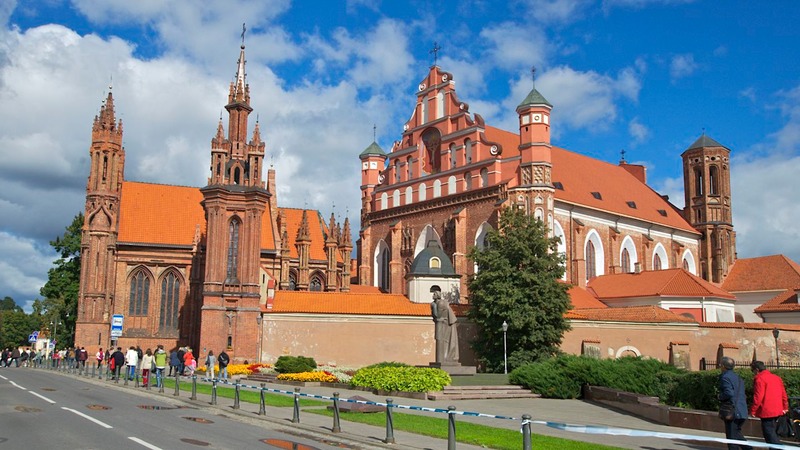
The first was the Orthodox Church of the Holy Spirit. It being a Sunday morning, services were underway and we try not to take pictures when inappropriate, which this certainly was. The church was medieval, with icons and paintings throughout, very dark and full of incense. An elderly woman wearing a white shawl was leading the small group in attendance; it was very dark and atmospheric. Absolutely amazing.
Our second favorite was St. Anne’s, said to be the most outstanding gothic building in Lithuania; it was a corker, that’s for sure. They say Napoleon was so impressed with it he wanted to take it back to Paris in the palm of his hand. Very English in look and feel, with a high arched brick interior mostly painted white, and lots of wood decorative elements. It was just plain lovely. And you know, it’s one thing to say this building or that is x hundreds of years old, but to picture a known historical figure like Napoleon standing in front of the same church you are looking at now, well that was pretty neat, and it is a really pretty church.
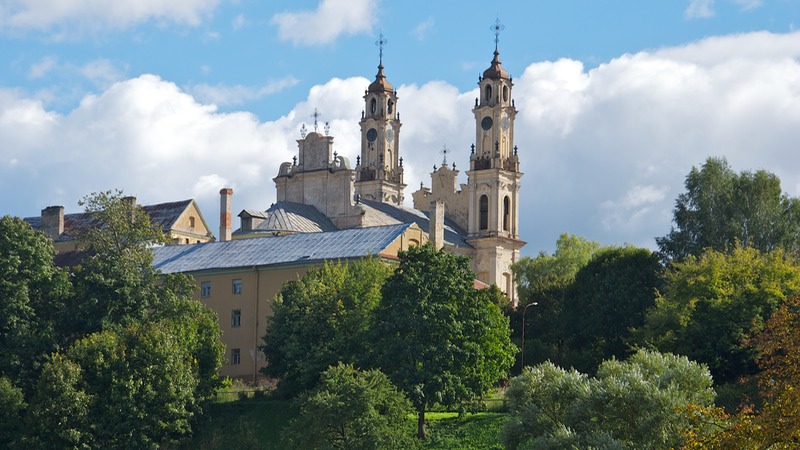
Vilnius has plenty to offer. We had intended to visit both the Genocide Museum and a memorial site outside town in the Paneriai forest, as well as the National Museum, but simply ran out of steam. It would take at least two full days to see it all. Also, we found we had no stomach for further atrocities, having seen all we could absorb for now. So we moved on. But, along with Riga and Tallinn, Vilnius had been a great experience.
Leaving, we were headed for Poland, along our route to Romania. We had noticed that Vilnius is home to a large Polish population, and we were interested in finding out more about that country. Given our time frame, our curiosity mostly would have to wait for another year, so we simply passed through several tiny towns out in the lovely southern Lithuanian countryside, each with a few houses and a large church, and finally crossed the border.
We really enjoyed the Baltic States. The cities were the big draw, but we also liked the countryside, with its neat and tidy vegetable gardens. Houses were scattered around, many of them very old, but also some new ones. Lots of large farm equipment; all the land was being worked, with nothing fallow. We had a strong sense of the land having been cleared and worked starting many generations earlier; the buildings often went back generations. There was a real sense of permanence among these people. It makes us understand the desire to come back – stay – whatever. People get resettled during the bad times, but they want to come back.
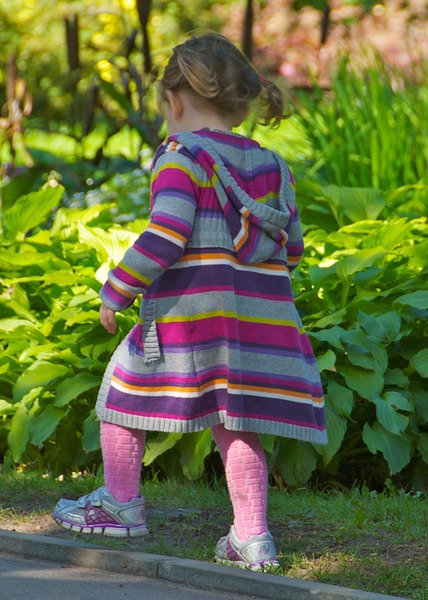
With the large percentage of Russians in each country, we wondered about their relationship to the “locals.” Is there still unease between the groups? We couldn’t tell. There were still tons of soviet-era buildings and “ruins.” How do people feel about this? All three countries are poor, with Lithuania said to be the poorest; we would agree from what we saw.
Our trip through Poland was quick; we took a major truck route that went straight south through the eastern part of the country. We then traversed the eastern edges of the Slovak Republic and Hungary (even though we were hurrying through, we had time for a couple of adventures – stay tuned). We want to spend lots of time in all three of these areas, another year. But for now, it is already mid-September, Romania and Turkey call out to us, and we want to keep moving, hopefully toward warmer weather. It’s been a long, cool summer, but we’ve noticed that both Romania and Turkey (with Bulgaria in between) are showing nice days ahead. We’re on our way. (This is actually being sent to you from sweltering Veliko Tarnovo, Bulgaria. We’ve arrived! Who was that complaining about cool weather anyway??)
Hugs from Rick and Kathy; and LT, currently getting her periodic servicing in another little Bulgarian garage.
Click to see more photos from Estonia, Latvia & Lithuania